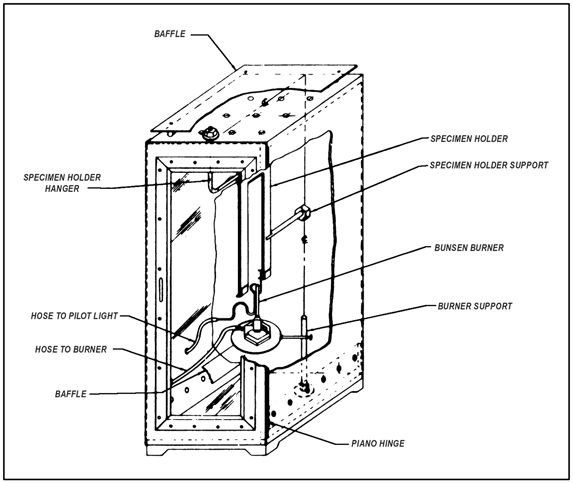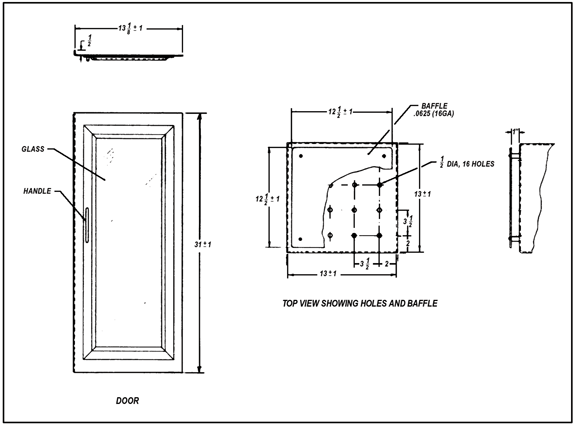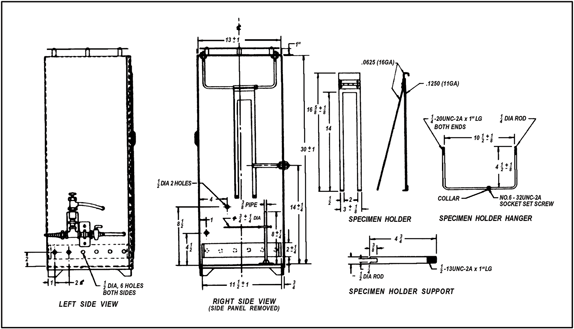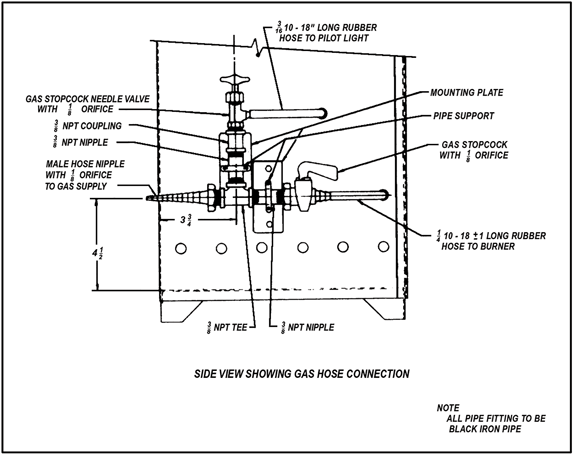['Fire Protection and Prevention']
['Fire Protection and Prevention']
03/19/2025
...
This appendix contains test methods which must be used to determine if protective clothing affords the required level of protection as specified in 1910.156, fire brigades.
(1) Puncture resistance test method for foot protection.
A. Apparatus. The puncture resistance test shall be performed on a testing machine having a movable platform adjusted to travel at 1/4 -inch/min (0.1 cm/sec). Two blocks of hardwood, metal, or plastic shall be prepared as follows: the blocks shall be of such size and thickness as to insure a suitable rigid test ensemble and allow for at least one-inch of the pointed end of an 8D nail to be exposed for the penetration. One block shall have a hole drilled to hold an 8D common nail firmly at an angle of 98°. The second block shall have a maximum 1/2 inch (1.3 cm) diameter hole drilled through it so that the hole will allow free passage of the nail after it penetrates the insole during the test.
B. Procedure. The test ensemble consisting of the sample unit, the two prepared blocks, a piece of leather outsole 10 to 11 irons thick, and a new 8D nail, shall be placed as follows: the 8D nail in the hole, the sample of outsole stock superimposed above the nail, the area of the sole plate to be tested placed on the outsole, and the second block with hole so placed as to allow for free passage of the nail after it passes through the outsole stock and sole plate in that order. The machine shall be started and the pressure, in pounds required for the nail to completely penetrate the outsole and sole plate, recorded to the nearest five pounds. Two determinations shall be made on each sole plate and the results averaged. A new nail shall be used for each determination.
C. Source. These test requirements are contained in “Military Specification For Fireman’s Boots,” MIL-B-2885D (1973 and amendment dated 1975) and are reproduced for your convenience.
(2) Test method for determining the strength of cloth by tearing: Trapezoid Method.
A. Test specimen. The specimen shall be a rectangle of cloth 3-inches by 6-inches (7.6 cm by 15.2 cm). The long dimension shall be parallel to the warp for warp tests and parallel to the filling for filling tests. No two specimens for warp tests shall contain the same warp yarns, nor shall any two specimens for filling tests contain the same filling yarns. The specimen shall be taken no nearer the selvage than 1/10 the width of the cloth. An isosceles trapezoid having an altitudeof 3-inches (7.6cm) and bases of 1 inch (2.5 cm) and 4 inches (10.2 cm) in length, respectively, shall be marked on each specimen, preferably with the aid of a template. A cut approximately 3/8 inch (1 cm) in length shall then be made in the center of a perpendicular to the 1-inch (2.5 cm) edge.
B. Apparatus. (i) Six-ounce (.17 kg) weight tension clamps shall be used so designed that the six ounces (.17 kg) of weight are distributed evenly across the complete width of the sample.
(ii) The machine shall consist of three main parts: Straining mechanism, clamps for holding specimen, and load and elongation recording mechanisms.
(iii) A machine wherein the specimen is held between two clamps and strained by a uniform movement of the pulling clamp shall be used.
(iv) The machine shall be adjusted so that the pulling clamp shall have a uniform speed of 12 ± 10.5 inches per minute (0.5 ± .02 cm/sec).
(v) The machine shall have two clamps with two jaws on each clamp. The design of the two clamps shall be such that one gripping surface or jaw may be an integral part of the rigid frame of the clamp or be fastened to allow a slight vertical movement, while the other gripping surface or jaw shall be completely moveable. The dimension of the immovable jaw of each clamp parallel to the application of the load shall measure one-inch, and the dimension of the jaw perpendicular to this direction shall measure three inches or more. The face of the movable jaw of each clamp shall measure one-inch by three inches.
Each jaw face shall have a flat smooth, gripping surface. All edges which might cause a cutting action shall be rounded to a radius of not over 1/64 inch (.04 cm). In cases where a cloth tends to slip when being tested, the jaws may be faced with rubber or other material to prevent slippage. The distance between the jaws (gage length) shall be one-inch at the start of the test.
(vi) Calibrated dial; scale or chart shall be used to indicate applied load and elongation. The machine shall be adjusted or set, so that the maximum load required to break the specimen will remain indicated on the calibrated dial or scale after the test specimen has ruptured.
(vii) The machine shall be of such capacity that the maximum load required to break the specimen shall be not greater than 85 percent or less than 15 percent of the rated capacity.
(viii) The error of the machine shall not exceed 2 percent up to and including a 50-pound load (22.6 kg) and 1 percent over a 50-pound load (22.6 kg) at any reading within its loading range.
(ix) All machine attachments for determining maximum loads shall be disengaged during this test.
C. Procedure. (i) The specimen shall be clamped in the machine along the nonparallel sides of the trapezoid so that these sides lie along the lower edge of the upper clamp and the upper edge of the lower clamp with the cut halfway between the clamps. The short trapezoid base shall be held taut and the long trapezoid base shall lie in the folds.
(ii) The machine shall be started and the force necessary to tear the cloth shall be observed by means of an autographic recording device. The speed of the pulling clamp shall be 12 inches ± 0.5 inch per minute (0.5 ± .02 cm/sec).
(iii) If a specimen slips between the jaws, breaks in or at the edges of the jaws, or if for any reason attributable to faulty technique, an individual measurement falls markedly below the average test results for the sample unit, such result shall be discarded and another specimen shall be tested.
(iv) The tearing strength of the specimen shall be the average of the five highest peak loads of resistance registered for 3 inches (7.6 cm) of separation of the tear.
D. Report. (i) Five specimens in each of the warp and filling directions shall be tested from each sample unit.
(ii) The tearing strength of the sample unit shall be the average of the results obtained from the specimens tested in each of the warp and filling directions and shall be reported separately to the nearest 0.1-pound (.05 kg).
E. Source. These test requirements are contained in “Federal Test Method Standard 191, Method 5136” and are reproduced for your convenience.
(3) Test method for determining flame resistance of cloth; vertical.
A. Test specimen. The specimen shall be a rectangle of cloth 2 3/4 inches (7.0 cm) by 12 inches (30.5 cm) with the long dimension parallel to either the warp or filling direction of the cloth. No two warp specimens shall contain the same warp yarns, and no two filling specimens shall contain the same filling yarn.
B. Number of determinations. Five specimens from each of the warp and filling directions shall be tested from each sample unit.
C. Apparatus. (i) Cabinet. A cabinet and accessories shall be fabricated in accordance with the requirements specified in Figures L-1, L-2, and L-3. Galvanized sheet metal or other suitable metal shall be used. The entire inside back wall of the cabinet shall be painted black to facilitate the viewing of the test specimen and pilot flame.
(ii) Burner. The burner shall be equipped with a variable orifice to adjust the flame height, a barrel having a 3/8 inch (1 cm) inside diameter and a pilot light.
(a) The burner may be constructed by combining a 3/8 inch (1 cm) inside diameter barrel 3 ± inches (7.6 ± .6 cm) long from a fixed orifice burner with a base from a variable orifice burner.
(b) The pilot light tube shall have a diameter of approximately 1/16 inch (.2 cm) and shall be spaced 1/8 inch (.3 cm) away from the burner edge with a pilot flame 1/8 inch (.3 cm) long.
(c) The necessary gas connections and the applicable plumbing shall be as specified in Figure L-4 except that a solenoid valve may be used in lieu of the stopcock valve to which the burner is attached. The stopcock valve or solenoid valve, whichever is used, shall be capable of being fully opened or fully closed in 0.1-second.
(d) On the side of the barrel of the burner, opposite the pilot light there shall be a metal rod of approximately 1/8 inch (.3 cm) diameter spaced 1/2 inch (1.3 cm) from the barrel and extending above the burner. The rod shall have two 5/16 inch (.8 cm) prongs marking the distances of 3/4 inch (1.9 cm) and 1 1/2 inches (3.8 cm) above the top of the burner.
(e) The burner shall be fixed in a position so that the center of the barrel of the burner is directly below the center of the specimen.
(iii) There shall be a control valve system with a delivery rate designed to furnish gas to the burner under a pressure of 2 1/2 ± 1/4 (psi) (17.5 ± 1.8 kPa) per square inch at the burner inlet (see (g)(3)(vi)(A)). The manufacturer’s recommended delivery rate for the valve system shall be included in the required pressure.
(iv) A synthetic gas mixture shall be of the following composition within the following limits (analyzed at standard conditions): 55 ± 3 percent hydrogen, 24 ± 1 percent methane, 3 ± 1 percent ethane, and 18 ± 1 percent carbon monoxide which will give a specific gravity of 0.365 ± 0.018(air + 1) and a B.T.U. content of 540 ± 20 per cubic foot (20.1 ± 3.7 kJ/L)(dry basis) at 69.8°F (21°C).
(v) There shall be metal hooks and weights to produce a series of total loads to determine length of char. The metal hooks shall consist of No. 19 gage steel wire or equivalent and shall be made from 3-inch (7.6 cm) lengths of wire and bent 1/2 inch (1.3 cm) from one end to a 45 degree hook. One end of the hook shall be fastened around the neck of the weight to be used.
(vi) There shall be a stop watch or other device to measure the burning time to 0.2-second.
(vii) There shall be a scale, graduated in 0.1 inch (.3 cm) to measure the length of char.
D. Procedure. (i) The material undergoing test shall be evaluated for the characteristics of after-flame time and char length on each specimen.
(ii) All specimens to be tested shall be at moisture equilibrium under standard atmospheric conditions in accordance with paragraph (3)C of this appendix. Each specimen to be tested shall be exposed to the test flame within 20 seconds after removal from the standard atmosphere. In case of dispute, all testing will be conducted under Standard Atmospheric Conditions in accordance with paragraph (3)C of this appendix.
(iii) The specimen in its holder shall be suspended vertically in the cabinet in such a manner that the entire length of the specimen is exposed and the lower end is 3/4 inch (1.9 cm) above the top of the gas burner. The apparatus shall be set up in a draft free area.
(iv) Prior to inserting the specimen, the pilot flame shall be adjusted to approximately 1/8 inch (.3 cm) in height measured from its lowest point to the tip.
The burner flame shall be adjusted by means of the needle valve in the base of the burner to give a flame height of 1 1/2 inches (3.8 cm) with the stopcock fully open and the air supply to the burner shut off and taped. The 1 1/2 inch (3.8 cm) flame height is obtained by adjusting the valve so that the uppermost portion (tip) of the flame is level with the tip of the metal prong (see Figure L-2) specified for adjustment of flame height. It is an important aspect of the evaluation that the flame height be adjusted with the tip of the flame level with the tip of the metal prong. After inserting the specimen, the stopcock shall be fully opened, and the burner flame applied vertically at the middle of the lower edge of the specimen for 12 seconds and the burner turned off. The cabinet door shall remain shut during testing.
(v) The after-flame shall be the time the specimen continues to flame after the burner flame is shut off.
(vi) After each specimen is removed, the test cabinet shall be cleared of fumes and smoke prior to testing the next specimen.
(vii) After both flaming and glowing have ceased, the char length shall be measured. The char length shall be the distance from the end of the specimen, which was exposed to the flame, to the end of a tear (made lengthwise) of the specimen through the center of the charred area as follows: The specimen shall be folded lengthwise and creased by hand along a line through the highest peak of the charred area. The hook shall be inserted in the specimen (or a hole, 1/4 inch (.6 cm) diameter or less, punched out for the hook)at one side of the charred area 1/4 inch (.6 cm) from the adjacent out- side edge and 1/4 inch (.6 cm) in from the lower end. A weight of sufficient size such that the weight and hook together shall equal the total tearing load required in Table L-2 of this section shall be attached to the hook.
(viii) A tearing force shall be applied gently to the specimen by grasping the corner of the cloth at the opposite edge of the char from the load and raising the specimen and weight clear of the supporting surface. The end of the tear shall be marked off on the edge and the char length measurement made along the undamaged edge.
Loads for determining char length applicable to the weight of the test cloth shall be as shown in Table L-2.
| Specified weight per square yard of cloth before any fire retardant treatment or coating—ounces | Total tearing weight for determining the charred length—pound |
|---|---|
| 1 To change into S.I. (System International) units, 1 ounce =28.35 grams, 1 pound =453 grams, 1 yard =.91 metre. | |
| 2.0 to 6.0 | 0.25 |
| Over 6.0 to 15.0 | 0.50 |
| Over 15.0 to 23.0 | 0.75 |
| Over 23.0 | 1.0 |
(ix) The after-flame time of the specimen shall be recorded to the nearest 0.2-second and the char length to the nearest 0.1-inch (.3 cm).
E. Report. (i) The after-flame time and char length of the sample unit shall be the average of the results obtained from the individual specimens tested. All values obtained from the individual specimens shall be recorded.
(ii) The after-flame time shall be reported to the nearest 0.2-second and the char length to the nearest 0.1-inch (.3 cm).
F. Source. These test requirements are contained in “Federal Test Method Standard 191, Method 5903 (1971)” and are reproduced for your convenience.
 |
| ILLUSTRATION FIGURE L-1 Vertical flame resistance textile apparatus. All given System International (S.I.) Unit: 1-inch= 2/54 cm. dimensions are in inches. |
 |
| FIGURE L-2 Vertical flame resistance textile apparatus, door and top view w/baffle. All given dimensions are in inches. System International (S.I.) Unit: 1-inch=2.54cm. |
 |
| FIGURE L-3 Vertical flame resistance textile apparatus, view and details. All given dimensions are in inches. System International (S.I.) Unit: 1 inch=2.54cm. |
 |
| FIGURE L-4 Vertical flame resistance textile apparatus. All given dimensions are in inches. System International (S.I.) Unit: 1 inch=2.54cm. |
[45 FR 60715, Sept. 12, 1980; 46 FR 24557, May 1, 1981]
['Fire Protection and Prevention']
['Fire Protection and Prevention']
UPGRADE TO CONTINUE READING
Load More
J. J. Keller is the trusted source for DOT / Transportation, OSHA / Workplace Safety, Human Resources, Construction Safety and Hazmat / Hazardous Materials regulation compliance products and services. J. J. Keller helps you increase safety awareness, reduce risk, follow best practices, improve safety training, and stay current with changing regulations.
Copyright 2025 J. J. Keller & Associate, Inc. For re-use options please contact copyright@jjkeller.com or call 800-558-5011.
